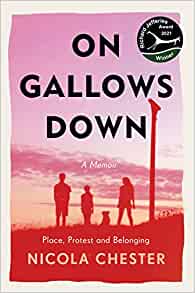Thanks to SLBI Member, Craig Swick, for another fascinating book review.

Nicola Chester, On Gallows Down: Place, Protest and Belonging (Chelsea Green Publishing 2021).
This is an extremely well written book in which the author describes her joys and struggles from living in a rural area of Berkshire. The natural world around her is physical and emotional home and she is constantly dealing with different threats to it.
The history of Berkshire is a backdrop to her own struggle and she explains its place in the Civil War, the peasant revolts of the 1830s, the protests in the 1970s when nuclear missiles were stored at an RAF base, and more recent threats to the natural world to make room for new highways. There is always a political and class struggle in the background: the poor and the tenant farmers are at odds with the government or the estate owners. Her view, to oversimplify it, is that the poor and the tenant farmers are on the side of preserving the wildlife and the government and estate owners are on the side of developing the land. The struggle has been going on for centuries and will undoubtedly be continuing long after the book ends.
She tells us about her childhood experiences with nature and how it gave her a sense of belonging. She says that belonging overrides everything else and bemoans the fact she can no longer recognize the place she grew up. I think we can all identify with going back to a place we used to live and see how much it has changed. Every time she moves, even if it is only a few miles, she comes to know the new place through its trees and wildlife. A theme that runs throughout the entire book is about who owns the land and who controls access to it. She is acutely aware that as a poor resident or a tenant farmer the land is not hers but she is still vitally interested in how it is used. There is a theme of trying to protect the land as well as a fear of its loss. This ranges from protesting the storage of nuclear missiles on what was once common land to her attempt to restore wildflowers and wildlife on estate land which then gets sprayed with herbicides.
Her life is interwoven with the natural and human history of the area. It amazes me how much literary history is associated with this small part of Berkshire. John Clare, one of the great nature poets, lived there and wrote about his own struggles to preserve nature against the estate owners. She, like Clare, had to do work she disagreed with in order to have food and a place to live. It is also the home to Kenneth Grahame (Wind in the Willows), whose style she often seems to re-create, lived nearby. He was a generation older so she did not know him personally but knew people who did. She even speculates about how the 5th Earl of Carnarvon was the likely model for Toad. John Keats lived in the area at one time. It is even the place of both the fictional and real Watership Down. The real place was threatened with development and the book, told from the rabbits’ viewpoint, is about exile, community and development in a rural area.
It is vitally important to her to teach children about the local plants and animals. She believes eight is the best age to take children to see badger setts at night and she describes the wonderful experiences she has with her children watching badgers and other animals at night. She strongly believes children should also be able to identify the trees around them. If they cannot learn the proper name, they can learn one that has meaning to them. She finds her children cannot remember the name for a horse chestnut but they can learn it is the “ice cream tree” when it is flowering and the “conker” tree in the fall.
Later in the book she becomes friends with the game warden on the Combe Estate who is also interested in helping preserve wild areas. At times they are able to persuade the estate manager to engage in better grazing rotations and preserve areas for wildflowers. But then after all their work the old head farmer retires and the new one mows everything down and sprays it with herbicide. It hard to educate people in new ways when they have their own idea of how to do the work.
One of the plants she strongly identifies with is mistletoe. She talks about their hanging like “great lampshades” on the row of lime trees at Highclere Estate (the place where much of “Downton Abbey” was filmed and where her husband worked for several years). On her own she harvests the berries and stores them in the freezer. She then “plants” them in trees later in the year. For her the hemiparisitic plant is the perfect image for the tenant farmer. It owns no ground and has no true roots but can thrive nevertheless. It is a lesson we should all bring what beauty we can to the natural world.
This is an outstanding book about growing up and learning about nature in Berkshire. Her writing style is so engaging I felt she was describing my own experiences even though my own upbringing was very different.
Craig Swick
February 2023
If you’d like to review a book for the SLBI Blog, please get in touch.
